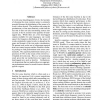Free Online Productivity Tools
i2Speak
i2Symbol
i2OCR
iTex2Img
iWeb2Print
iWeb2Shot
i2Type
iPdf2Split
iPdf2Merge
i2Bopomofo
i2Arabic
i2Style
i2Image
i2PDF
iLatex2Rtf
Sci2ools
ACL
2004
2004
Finding Predominant Word Senses in Untagged Text
In word sense disambiguation (WSD), the heuristic of choosing the most common sense is extremely powerful because the distribution of the senses of a word is often skewed. The problem with using the predominant, or first sense heuristic, aside from the fact that it does not take surrounding context into account, is that it assumes some quantity of handtagged data. Whilst there are a few hand-tagged corpora available for some languages, one would expect the frequency distribution of the senses of words, particularly topical words, to depend on the genre and domain of the text under consideration. We present work on the use of a thesaurus acquired from raw textual corpora and the WordNet similarity package to find predominant noun senses automatically. The acquired predominant senses give a precision of 64% on the nouns of the SENSEVAL2 English all-words task. This is a very promising result given that our method does not require any hand-tagged text, such as SemCor. Furthermore, we dem...
| Added | 30 Oct 2010 |
| Updated | 30 Oct 2010 |
| Type | Conference |
| Year | 2004 |
| Where | ACL |
| Authors | Diana McCarthy, Rob Koeling, Julie Weeds, John A. Carroll |
Comments (0)

